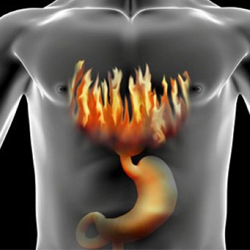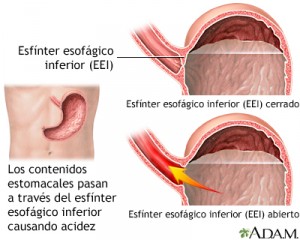
GASTROESOPHAGEAL REFLUX DISEASE
Gastroesophageal reflux disease (also known as esophageal reflux or simply reflux) is a common problem in Guatemala. According to recent statistics, about 80% of people will suffer from symptoms at one point of their lives. One out of three people will have symptoms at least 3 times per week.
WHAT IS GASTROESOPHAGEAL REFLUX DISEASE?
Our digestive system is designed as a one-way street: food goes from our mouths to the esophagus and into the stomach, where the digestion begins, and the nutrients reach the intestines where they are absorbed into the blood. Esophageal reflux occurs when part of the stomach contents (like food, gastric acid, bile, etc.) return to the esophagus.
During the digestive process, food is mixed with the acid that is produced in the stomach. Of the entire digestive tract, only the stomach has the proper inner layer that protects it from being in contact with the acid. In people with esophageal reflux, the stomach content reaches the esophagus, which is not intended to be in contact with the gastric acid. When this occurs frequently, the acid burns the inner walls of the esophagus causing a severe inflammation known as esophagitis.
DEFENSE MECHANISMS AGAINST GASTROESOPHAGEAL REFLUX
The most distal part of the esophagus has a circular muscle that works as a valve, allowing food to go down into the stomach and preventing it to come back to the esophagus. This muscle, called the lower esophageal sphincter, has an established pressure that closes the esophagus. The pressure inside the stomach increases during the digestion of food. If the pressure increases too much, it could force open the muscle and open the sphincter, allowing food and the gastric contents to return to the esophagus, causing gastroesophageal reflux.
Another defense mechanism is a propulsive system in the esophagus that thrusts the acid back into the stomach. This prevents the acid from staying in the esophagus burning its inner layer. Nonetheless, the constant reflux of acid causes an inflammatory process that have a negative influence in the function of the propulsion system in the esophagus, causing a vicious circle: the inflammatory process hinders the esophageal function, which allows the acid to be in contact with the esophagus during a prolonged period of time, causing more inflammation.
Lastly, there is a difference in pressures between the chest (which is negative) and the abdomen (which is positive). To avoid reflux from occurring, there have to be at least 2 cm of esophagus inside the abdomen.
CAUSES OF GASTROESOPHAGEAL REFLUX
The most important cause of gastroesophageal reflux is obesity. This is because there is an increased pressure inside the abdomen that beats the resistance of the lower esophageal sphincter muscle. This is the same reason why gastroesophageal reflux symptoms are more common during pregnancy. Other causes of gastroesophageal reflux are certain medications, coffee, chocolate, mint, fatty meals, spicy foods, certain condiments, etc.

HIATAL HERNIA AND GASTROESOPHAGEAL REFLUX
The diaphragm is a muscle that divides the chest from the abdomen. Its function is to allow us to breath. However, some structures like the esophagus go from the chest to the abdomen through the diaphragm. The small opening through which the esophagus traverses the diaphragm is called the esophageal hiatus. A hiatal hernia occurs when this opening increases in size. The difference in pressures between the chest and the abdomen pushes part of the stomach into the chest. In other words, patients with hiatal hernias have part of their stomach inside their chest. This promotes gastroesophageal reflux.
Since the hiatal hernia is an anatomical cause of gastroesophageal reflux, it cannot be treated with medical management. When a hiatal hernia is related to gastroesophageal reflux, the recommended treatment is surgery. The surgical treatment of a hiatal hernia is part of an antireflux operation.
SYMPTOMS OF GASTROESOPHAGEAL REFLUX DISEASE
The gastroesophageal reflux symptoms occur when the gastric acid is constantly reaching the esophagus. Therefore, the most frequent symptom is heartburn, which is a burning sensation behind the chest bone. Other symptoms include regurgitation of food, chest pain and difficulty in swallowing food.
Less common gastroesophageal symptoms (also called atypical symptoms) occur when the acid is ejected forcefully from the stomach reaching all the way to the throat. This can cause the following:
- Swelling of the vocal cords, causing hoarseness
- Swelling of the maxillary sinus, causing sinusitis or sinus infection
- Aspiration of acid into the lungs causing chronic cough, symptoms similar to asthma, and recurrent pneumonias
DIAGNOSIS OF GASTROESOPHAGEAL REFLUX DISEASE
In most cases, the symptoms of gastroesophageal reflux are distinctive of the disease. However, in case of doubt or in people who have atypical gastroesophageal reflux symptoms, it is often recommended to undergo the following diagnostic tests:
- Endoscopy (also known as endoscopic gastroduodenoscopy or EGD): consists of introducing a small camera through the mouth towards the stomach allowing the doctor to do a detailed evaluation of the inner layer of the esophagus, stomach, and duodenum (the first portion of the small bowel). With this test, it is possible to determine if there is evidence of inflammation in the esophagus (esophagitis) or suspicion of a precancerous disease (Barrett’s esophagus). Additionally, it is possible to do biopsies for microscopic evaluation of the affected segments of the digestive tract. Through endoscopy it is also possible to identify the presence of a hiatal hernia.
The endoscopy is also useful to diagnose other pathologies of the digestive tract, such as polyps, cancer, esophageal strictures, ulcers, gastritis, duodenitis, etc. - pH monitoring: a small sensor that measures the pH is introduced inside the esophagus to determine the presence of acid throughout 24-48 hours. During this period, it is possible to measure how many episodes of reflux occur, if the reflux content is mainly gastric acid, if the symptoms are related to the reflux episodes, the amount of time the acid is in contact with the esophagus, etc.
Esophageal mannometry: this test measures the pressure of the lower esophageal sphincter muscle and the esophageal function. Consequently, it is possible to determine if the pressure in the lower esophageal muscle is normal and if the esophagus works properly.
COMPLICATIONS OF GASTROESOPHAGEAL REFLUX DISEASE
When the gastroesophageal reflux disease is severe or chronic, it can cause the following complications:
- Esophagitis: as previously mentioned, the esophagus is not designed to be in contact with the gastric acid. When gastroesophageal reflux occurs, the acid constantly burns the inner layer of the esophagus. On the long run it causes a severe inflammation known as esophagitis.
- Esophageal ulcers: same as in the stomach, esophageal ulcers can occur when the acid causes a severe injury to the walls of the esophagus.
- Barrett’s esophagus: when esophagitis occurs, the esophagus creates new cells in order to heal its walls. When the esophagitis occurs repeatedly, the creation of new cells becomes disorganized. In medicine, this is known as a metaplasia. Barrett’s esophagus is a precancerous conditions caused by the disorganized creation of new cells in the esophagus. The incidence of Barrett’s esophagus in Guatemala is around 1% of the total population. However, Barrett’s esophagus in Guatemala is present in 10% of people with severe esophagitis derived from gastroesophageal reflux disease.
MEDICAL TREATMENT OF GASTROESOPHAGEAL REFLUX DISEASE
- Lifestyle changes: in people with mild and typical gastroesophageal reflux, a change in diet and life style could improve or even prevent symptoms. These include losing weight, stop smoking, stop drinking alcohol, reduce the amount of fatty and spicy foods.
- Medications: when lifestyle changes do not improve gastroesophageal symptoms it is often recommended to undergo a course of medical therapy. Antacids neutralize the acid in the stomach and esophagus. Other medications reduce the amount of acid produced in the stomach. Additionally, other medications increase the pressure of the lower esophageal sphincter and promote gastric emptying, therefore decreasing the pressure inside the stomach and reducing the amount of gastroesophageal reflux.
ANTIREFLUX SURGERY
The surgery for the treatment of gastroesophageal reflux has been performed in Guatemala since over 20 years ago. Those patients who do not respond adequately to lifestyle changes or medications can be evaluated to determine if they are candidates for antireflux surgery.
The name of the operation is Nissen fundoplication and is performed through laparoscopic surgery. A small camera and instruments of about 5-10 millimeters in diameter are introduced in the abdomen. The Nissen fundoplication consists of the following steps:
- Returning at least 2 cm of esophagus inside the abdomen
- Surgical correction of the hiatal hernia
- Reinforcement of the lower esophageal sphincter by wrapping part of the stomach around the distal portion of the esophagus
In the Nissen fundoplication there is no need to divide the esophagus or the stomach. The stomach is simply wrapped around the esophagus. Therefore, there is a much lower risk. Patients require an overnight hospital stay. After surgery, patients are started on a liquid diet and are slowly advanced to a soft diet and subsequently to a regular diet. This process takes between two to three weeks.
The results of antireflux surgery are excellent. However, it should be done by a surgeon with proper training both in gastrointestinal and laparoscopic surgery. Furthermore, it should be performed in patients who fill the criteria to be considered candidates to undergo the operation.
Dr. Rodrigo Gonzalez from Guatemala completed his training in Digestive Surgery at the Louis Pasteur University in Strasbourg, France and has a surgical specialty in Advanced Laparoscopic Gastrointestinal Surgery from Emory University, Atlanta, GA and the University of South Florida, Tampa, FL.
The surgical specialty of Dr. Rodrigo Gonzalez involves:
- Diagnosis of gastroesophageal reflux disease, including endoscopy (EGD)
- Evaluation of potential candidates for the surgery, including interpretation of pH-monitoring and esophageal mannometry
- Management of gastroesophageal reflux disease through medical treatment and through antireflux surgery




